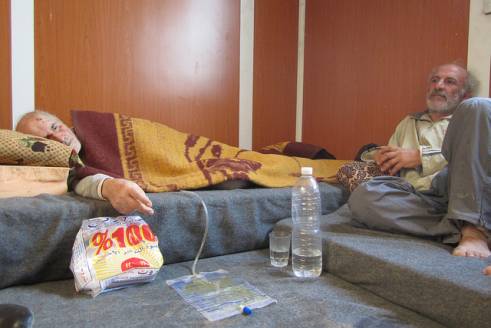By Attila Kulscar
HelpAge International is currently collaborating with Handicap International on its response to the Syrian refugee crisis in Jordan.
We are using our joint expertise to identify the needs of the most vulnerable groups affected by the conflict in Syria, including older people and people with disabilities, to ensure they can get essential relief services.
Two years after the conflict in Syria began with demonstrations against the government of President Bashar al-Assad, the number of Syrians fleeing the country each day is rising dramatically.

The number of registered refugees outside Syria is now in excess of 1.1 million – with a sharp rise in the numbers of people fleeing Syria over the last few weeks.
The conflict has left more than 70,000 people dead and two million internally displaced.
More funds needed to deal with huge numbers of refugees
The UN High Commission for Refugees (UNHCR) suggests the number of refugees arriving in neighbouring countries might reach as high as three million by the end of the year if no solution is found.
If these forecasts come true, it would make Syria the world’s biggest refugee problem area, ahead of Afghanistan and Iraq.
Jordan is hosting the largest share of refugees in the region – 34% of the registered total.
There are currently about 332,000 refugees either registered or awaiting registration inside Jordan, with additionally more than 80,000 refugees unregistered.
Aid agencies have called for more funds to deal with the huge numbers.
The proportion of older refugees leaving Syria is also rising and there are now about 9,000 older refugees registered in Jordan.
In addition to this number, there are also unregistered refugees who don’t receive the food, emergency assistance and free health care provided to those who are registered.
Older refugees disproportionately at risk
The main refugee camp in the north of Jordan, Za’atari camp, hosts more than 144,000 refugees. The camp is overcrowded and a lack of access to food has been reported.
People over the age of 60 make up around 3% of the Za’atari camp population – an increase from 2% since the beginning of the year. An older woman who arrived last week was 105 years old.
UNHCR data from Za’atri camp shows that while refugees aged 60 and over constitute 3% of the residents, they account for 7% of the acute health conditions and 21% of chronic health conditions, such as diabetes and high blood pressure.
This indicates older refugees are disproportionately at risk and in need of greater humanitarian assistance. However medical facilities in Za’atari camp are becoming increasingly overburdened.
On dialysis and unable to chew his food
Mahbud, 69, arrived with his son Hisham, 52, two weeks ago. Mahbud is partially paralysed due to a stroke and cannot speak. He also needs dialysis twice a week. The two live together in the camp, but Hisham does not know what services are available for his father. Mahbud cannot chew the food given to the residents of the camp.
Hisham said: “He is my father – I will help him, no matter what. There has been no electricity in the camp for the last four days, so I have not been able to use the blender I bought to prepare his food and the lack of gas means I cannot cook. The priority should be to improve the bathrooms and kitchens as they are crowded and dirty.”
Urban refugees less likely to receive help
Many Syrian refugees are leaving the camps to move to urban areas, joining thousands of other refugees who are already living in cities with relatives or contacts along the northern border between Syria and Jordan. This largely invisible population – estimated at about 75% of the refugee population – is relying heavily on the support of their Jordanian neighbours.
Reaching the refugee population in urban areas is a challenge as they are dispersed and their addresses are not always easy to find.
Many of the refugees living among the local population are vulnerable as they are less likely to get help than those who are sheltered in the refugee camp. Outreach activities are essential to locate them and provide them with a minimum of aid.
It is clear that many people are struggling to cover the cost of their basic essentials. The latest research shows that the average level of debt among these urban refugees is US$650 – a figure which represents about three months’ rent. On top of this, the average shortfall in monthly income for this group is almost US$250.
HelpAge, in partnership with Handicap International, is planning to strengthen our assistance to older, disabled and other vulnerable refugees living in the urban areas of Jordan and Lebanon, notably in terms of access to housing, electricity and heating, clothing, food and healthcare.
Crisis in Syria: How you can help
To make a donation to the DEC Syria Crisis Appeal:
Text: Donate £5 by texting the word SUPPORT to 70000.
Online: Donate to the DEC appeal.
Phone: Call the 24 hour hotline on 0370 60 60 900
In person: Donate over the counter at any high street bank or post office, or send a cheque.
Outside of the UK: Donate via HelpAge International.
